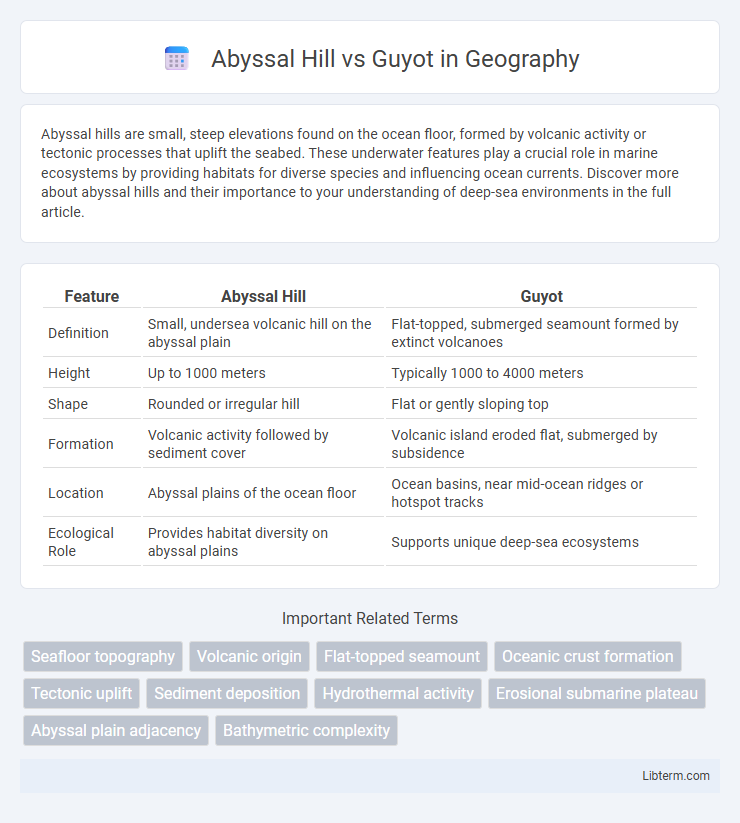Abyssal hills are small, steep elevations found on the ocean floor, formed by volcanic activity or tectonic processes that uplift the seabed. These underwater features play a crucial role in marine ecosystems by providing habitats for diverse species and influencing ocean currents. Discover more about abyssal hills and their importance to your understanding of deep-sea environments in the full article.
Table of Comparison
| Feature | Abyssal Hill | Guyot |
|---|---|---|
| Definition | Small, undersea volcanic hill on the abyssal plain | Flat-topped, submerged seamount formed by extinct volcanoes |
| Height | Up to 1000 meters | Typically 1000 to 4000 meters |
| Shape | Rounded or irregular hill | Flat or gently sloping top |
| Formation | Volcanic activity followed by sediment cover | Volcanic island eroded flat, submerged by subsidence |
| Location | Abyssal plains of the ocean floor | Ocean basins, near mid-ocean ridges or hotspot tracks |
| Ecological Role | Provides habitat diversity on abyssal plains | Supports unique deep-sea ecosystems |
Introduction to Abyssal Hills and Guyots
Abyssal hills are small, gently sloping features rising from the abyssal plains, typically less than 1,000 meters in height and formed by volcanic or tectonic activity. Guyots, also known as tablemounts, are flat-topped seamounts that have been eroded by wave action when they were above sea level before subsiding to abyssal depths. Both geological structures provide critical insights into oceanic crust formation and the history of sea level changes.
Geological Formation Processes
Abyssal hills form primarily through volcanic activity and tectonic processes at mid-ocean ridges, created by the cooling and fracturing of the oceanic crust as magma solidifies and spreads. Guyots develop from extinct volcanic islands that initially form above sea level and are subsequently flattened by wave erosion before subsiding below the ocean surface due to crustal cooling and isostatic adjustments. The key difference lies in their origin, with abyssal hills being smaller volcanic features on the ocean floor and guyots representing submerged, eroded volcanic islands with flat tops.
Morphological Differences
Abyssal hills are small, elongated, or rounded seafloor features typically less than 1,000 meters high, formed by volcanic activity along mid-ocean ridges. Guyots, also known as tablemounts, are large, flat-topped seamounts with heights often exceeding 1,000 meters, created by volcanic islands that have undergone erosion and subsidence. The primary morphological difference lies in their size and shape: abyssal hills are smaller and more irregular, while guyots exhibit a distinct flat summit resulting from wave erosion at sea level before sinking.
Distribution in Ocean Basins
Abyssal hills are predominantly found along mid-ocean ridges and cover extensive areas in the Atlantic and Pacific Ocean basins, forming the most abundant topographic features on the seafloor. Guyots, also known as tablemounts, are widespread in the Pacific Ocean basin, particularly in regions like the Hawaiian-Emperor seamount chain, where they represent submerged volcanic islands with flat tops. The distribution of abyssal hills is closely linked to tectonic spreading centers, while guyots are typically associated with hotspot volcanic activity and seamount chains in oceanic plate interiors.
Age and Evolution
Abyssal hills are typically younger underwater volcanic features formed by seafloor spreading and tectonic activity, often less than 100 million years old. Guyots, or tablemounts, are older seamounts that have been eroded flat by wave action and subsidence, frequently exceeding 120 million years in age. The evolution from abyssal hill to guyot involves prolonged volcanic inactivity, subsidence, and erosion processes that shape their distinct topographies over geological timescales.
Ecological Significance
Abyssal hills and guyots both contribute uniquely to marine biodiversity by offering diverse habitats on the ocean floor, supporting specialized communities of benthic organisms. Abyssal hills create complex topographies that influence deep-sea currents and nutrient distribution, enhancing localized ecological productivity. Guyots, with their flat-topped structures, serve as underwater plateaus that provide stable substrates for coral and sponge assemblages, playing a critical role in sustaining marine ecosystems and biological diversity.
Role in Plate Tectonics
Abyssal hills and guyots play distinct roles in plate tectonics, with abyssal hills representing seafloor spreading processes as small volcanic features aligned along mid-ocean ridges. Guyots, flat-topped seamounts, indicate past volcanic islands that subsided due to plate movement and cooling of the oceanic lithosphere. The presence of abyssal hills helps trace divergent plate boundaries, while guyots provide evidence for the interaction between volcanic activity and plate subsidence over geological time.
Sediment Accumulation Patterns
Abyssal hills exhibit consistent sediment accumulation patterns characterized by thin, patchy sediment cover due to their relatively small size and active tectonic settings. Guyots, with their flat-topped submerged volcanic structures, accumulate thicker, more uniform sediment layers resulting from prolonged quiescent periods allowing pelagic sedimentation and carbonate buildup. Sediment distribution differences between abyssal hills and guyots are influenced by morphology, ocean currents, and biological productivity in deep-sea environments.
Importance in Marine Research
Abyssal hills and guyots represent significant geological structures on the ocean floor, with abyssal hills being smaller, sediment-covered volcanic features, while guyots are flat-topped seamounts that provide insights into paleoceanographic conditions. Their study aids marine researchers in understanding seafloor spreading rates, volcanic activity, and past sea-level changes, offering critical data for plate tectonics and climate change models. Mapping these structures also supports biodiversity assessments by identifying unique habitats for deep-sea organisms, crucial for conservation strategies.
Comparative Summary: Abyssal Hill vs Guyot
Abyssal hills are small, extinct volcanic features rising less than 1,000 meters above the ocean floor, whereas guyots are larger, flat-topped seamounts typically exceeding 1,000 meters in height. Abyssal hills have gentle slopes and are common on mid-ocean ridges, while guyots display eroded summits caused by wave action before subsidence. Both formations result from volcanic activity but differ significantly in size, shape, and geological history.
Abyssal Hill Infographic

 libterm.com
libterm.com